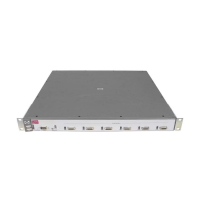Static Virtual LANs (VLANs)
Static VLAN Operation
Protocol VLAN Environment. Figure 2-2 can also be applied to a protocol
VLAN environment. In this case, VLANs “W” and “X” represent routable
protocol VLANs. VLANs “Y” and “Z” can be any protocol VLAN. As noted for
the discussion of multiple port-based VLANs, VLAN 1 is not shown. Enabling
internal (IP) routing on the switch allows IP traffic to move between VLANs
on the switch. However, routable, non-IP traffic always requires an external
router.
Routing Options for VLANs
Table 2-3. Options for Routing Between VLAN Types in the Switch
Port- IPX IPv4 IPv6 ARP Apple SNA
2, 3
DEClat
2, 3
Netbeui
2
Based -Talk
Port-Based Yes — Yes — — — — — —
Protocol
IPX — Yes
1
— — — — — — —
IPv4 Yes — Yes — — — — — —
IPv6 — — — Yes
1
— — — — —
ARP — — — — Yes
1
— — — —
AppleTalk — — — — — Yes
1
— — —
SNA
2, 3
— — — — — — — — —
DEClat
2, 3
— — — — — — — — —
NETbeui
2
— — — — — — — — —
1
Requires an external router to route between VLANs.
2
Not a routable protocol type. End stations intended to receive traffic in these protocols must
be attached to the same physical network.
3
Protocol VLAN type not supported on the Series 3400cl and 6400cl switches.
Overlapping (Tagged) VLANs
A port can be a member of more than one VLAN of the same type if the device
to which the port connects complies with the 802.1Q VLAN standard. For
example, a port connected to a central server using a network interface card
(NIC) that complies with the 802.1Q standard can be a member of multiple
VLANs, allowing members of multiple VLANs to use the server. Although these
VLANs cannot communicate with each other through the server, they can all
access the server over the same connection from the switch. Where VLANs
2-9

